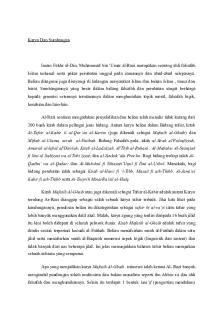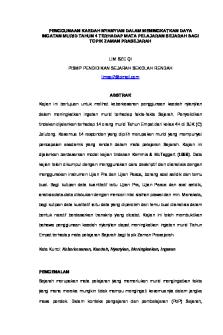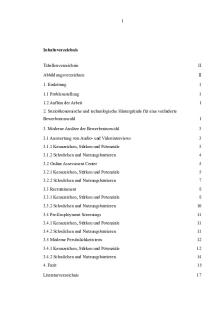Contemporaneity of AR and MR Notes PDF

| Title | Contemporaneity of AR and MR Notes |
|---|---|
| Course | LAW |
| Institution | Liverpool John Moores University |
| Pages | 2 |
| File Size | 84.6 KB |
| File Type | |
| Total Downloads | 71 |
| Total Views | 131 |
Summary
Summary sheet on rules of Contemporaneity of AR and MR. ...
Description
Contemporaneity (aka Coincidence) of Actus Reus and Mens Rea As we have noted, the actus reus and mens rea of a given crime must be contemporaneous. This means they must coincide at the same point in time. There are a range of exceptions to this which are explored below.
In some cases, mens rea will be present first and the actus reus will follow later. These circumstances can found liability even though they violate the contemporaneity/coincidence principle: they are an exception. In Thabo Meli, the defendants as part of a pre-conceived plan struck V over the head. Thinking V was dead, they threw what they thought was V’s corpse over a cliff. Medical evidence later showed that that the blow to the head had not killed V: but being thrown over the cliff had killed V. The Privy Council held that the defendants could be convicted of murder, as whilst the mens rea occurred first and then the actus reus happened later, the acts were part of a plan and so could be described as part of ONE TRANSACTION.
This principle was applied in Church where D in a sudden fight knocked V unconscious and, wrongly believing V to be dead, threw her into a river where she drowned. Whilst there was no antecedent plan, the court described the whole course of conduct as a ‘series of acts which culminated in V’s death’. This is an extremely flexible approach to the principle of contemporaneity and facilitates convictions in awkward fact scenarios.
Indeed, this approach was followed in Le Brun where there was also no preconceived plan. D hit his wife, V, and she collapsed. He then picked up her body and took it inside. He dropped her and, due to this blow to the head, she died. The court said his conviction for manslaughter stood as the hitting and carrying of the body could be regarded as one transaction or a single ‘sequence of events’. Key here was that D was carrying her inside to hide what he had done. Some writers note that had D been taking V to the doctor and dropped her, the court may well not have viewed it as one series of events. The approach in all these cases, where sometimes there is an interval of time between the intention and the guilty act, was upheld in A-G’s Ref (3/1994).
In other cases, the actus reus is present first; the mens rea occurs later. Here the courts have used 2 explanations: the continuing act theory: see Fagan; and the creation of a danger duty where omissions liability will flow: Miller.
What if there are multiple actus rei? In A-G’s Ref (4/1980), D slapped his girlfriend, V, and pushed her down the stairs, put a rope around her neck, dragged her back upstairs, cut her throat and then cut her body into pieces. It was unclear which of these acts had caused her death and at which point D had formed the mens rea! The CA held that as long as D had the necessary mens rea at the time of each of the possible acts that caused death, he could properly be convicted of murder or manslaughter....
Similar Free PDFs

AR-RAZI - ar razi
- 3 Pages

Artikel ar
- 35 Pages

Dr Jeckill and mr hyde
- 4 Pages

Manual Ar - Lecture notes 4-7
- 1 Pages

Data visualization via VR and AR
- 2 Pages

Wi Ar 190503 final
- 16 Pages
Popular Institutions
- Tinajero National High School - Annex
- Politeknik Caltex Riau
- Yokohama City University
- SGT University
- University of Al-Qadisiyah
- Divine Word College of Vigan
- Techniek College Rotterdam
- Universidade de Santiago
- Universiti Teknologi MARA Cawangan Johor Kampus Pasir Gudang
- Poltekkes Kemenkes Yogyakarta
- Baguio City National High School
- Colegio san marcos
- preparatoria uno
- Centro de Bachillerato Tecnológico Industrial y de Servicios No. 107
- Dalian Maritime University
- Quang Trung Secondary School
- Colegio Tecnológico en Informática
- Corporación Regional de Educación Superior
- Grupo CEDVA
- Dar Al Uloom University
- Centro de Estudios Preuniversitarios de la Universidad Nacional de Ingeniería
- 上智大学
- Aakash International School, Nuna Majara
- San Felipe Neri Catholic School
- Kang Chiao International School - New Taipei City
- Misamis Occidental National High School
- Institución Educativa Escuela Normal Juan Ladrilleros
- Kolehiyo ng Pantukan
- Batanes State College
- Instituto Continental
- Sekolah Menengah Kejuruan Kesehatan Kaltara (Tarakan)
- Colegio de La Inmaculada Concepcion - Cebu









